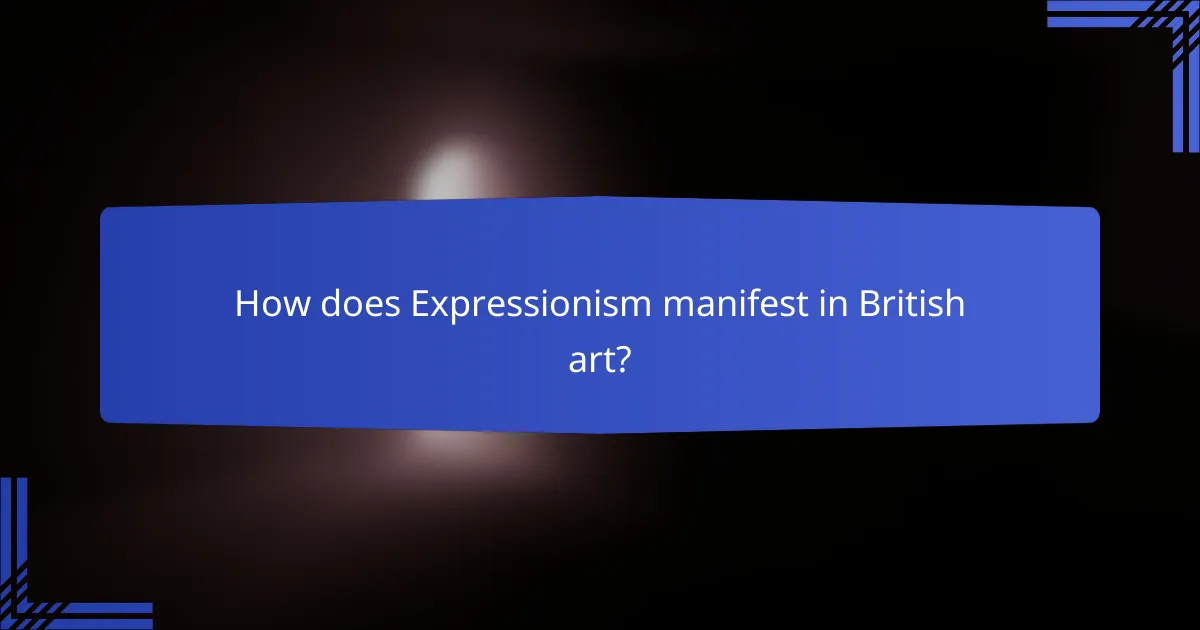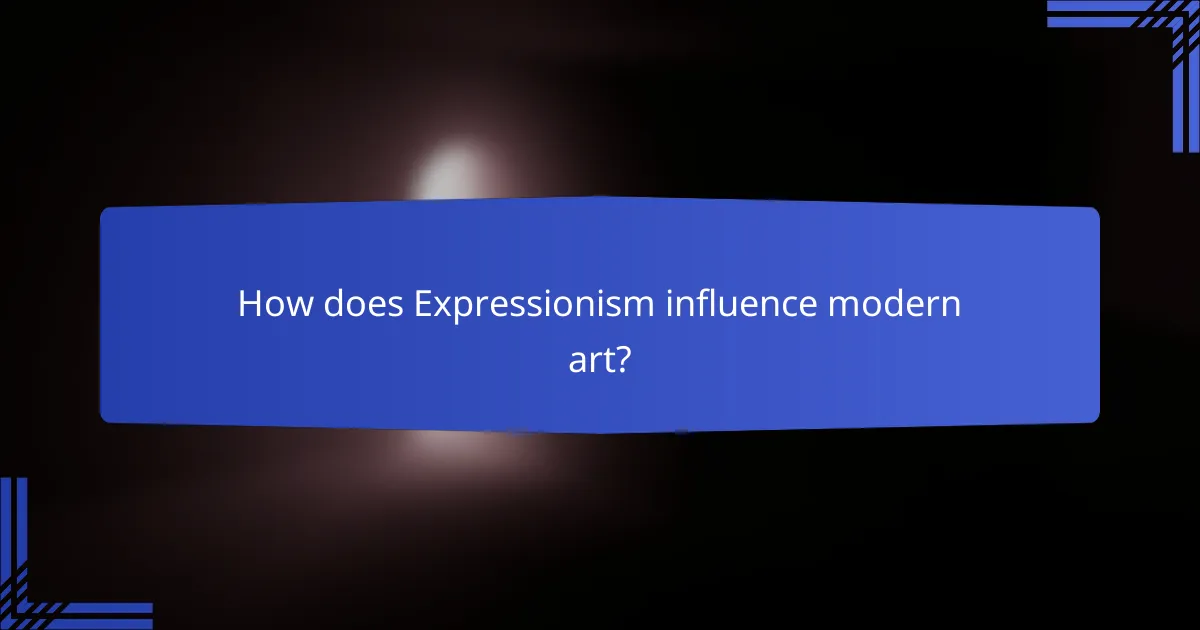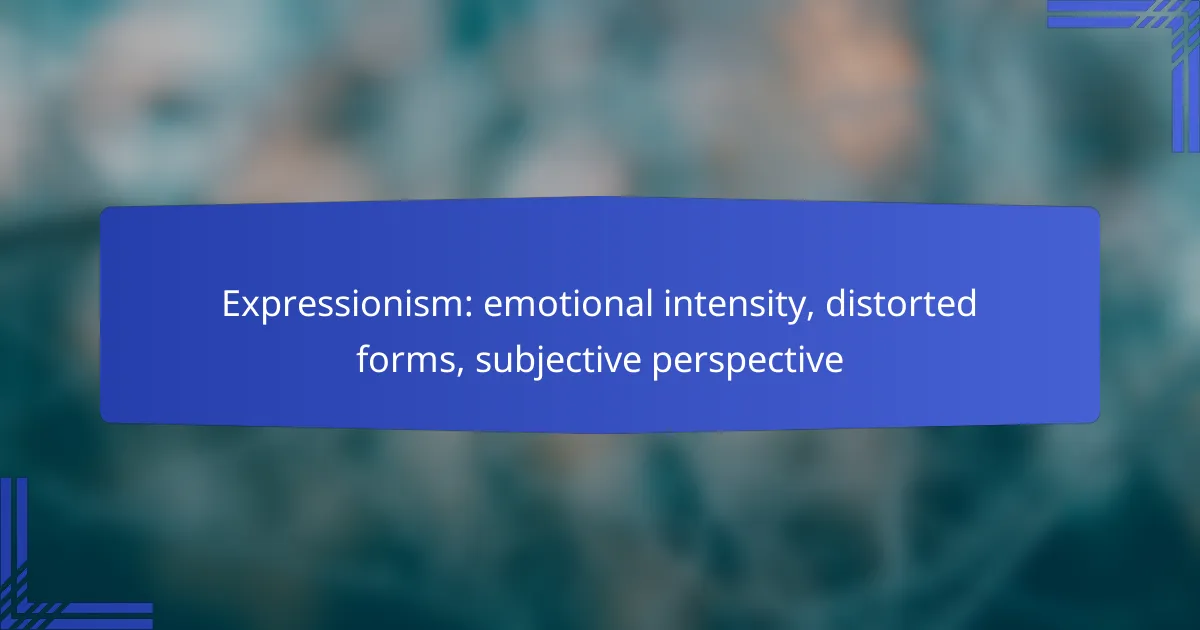Expressionism is an art movement that emphasizes emotional intensity, distorted forms, and subjective perspectives. It seeks to convey the artist’s inner feelings rather than merely represent external reality, resulting in striking and unconventional visual experiences. Through innovative techniques, artists evoke deep emotions and personal narratives, inviting viewers to engage with their work on a profound level.

How does Expressionism manifest in British art?
Expressionism in British art is characterized by its emotional intensity, distorted forms, and subjective perspectives. Artists often convey deep feelings and personal experiences, using unconventional techniques to evoke strong reactions from viewers.
Emotional intensity in British Expressionism
Emotional intensity is a hallmark of British Expressionism, where artists prioritize feelings over realistic representation. This movement often reflects the tumultuous social and political climate, channeling anxiety, joy, or despair through bold colors and dynamic brushwork.
For instance, artists like Francis Bacon and Edvard Munch explore themes of existential dread and human suffering, using distorted figures to amplify emotional impact. Their works resonate deeply, inviting viewers to confront their own emotions and experiences.
Distorted forms in notable works
Distorted forms are prevalent in notable works of British Expressionism, where artists manipulate shapes and proportions to convey psychological states. The distortion serves to challenge traditional aesthetics, creating a sense of unease or tension.
In pieces such as Bacon’s “Study after Velázquez’s Portrait of Pope Innocent X,” the figure appears grotesque and unsettling, emphasizing the inner turmoil of the subject. This approach encourages viewers to engage with the artwork on a visceral level, rather than merely appreciating its visual appeal.
Subjective perspective in contemporary pieces
Contemporary British Expressionism often embraces a subjective perspective, allowing artists to express personal narratives and cultural critiques. This approach fosters a diverse range of interpretations, as each viewer brings their own experiences to the artwork.
Artists like Tracey Emin and Jenny Saville utilize their unique viewpoints to explore themes of identity, trauma, and femininity. Their work often blurs the lines between personal and collective experiences, inviting dialogue and reflection on societal issues.

What are the key characteristics of Expressionism?
Expressionism is characterized by its emotional intensity, distorted forms, and subjective perspective. This art movement seeks to convey the artist’s inner feelings rather than represent external reality, often resulting in striking and unconventional visual experiences.
Use of vibrant colors
Vibrant colors are a hallmark of Expressionism, used to evoke strong emotions and convey mood. Artists often employed bold, non-naturalistic colors to express feelings rather than to depict the actual appearance of subjects.
For example, a landscape might be painted in exaggerated reds and yellows to reflect a sense of turmoil or passion. This use of color can create a visceral reaction in the viewer, enhancing the emotional impact of the artwork.
Exaggerated forms and proportions
Expressionist artists frequently distorted forms and proportions to emphasize emotional content. Figures may be elongated or exaggerated in size to reflect feelings of anxiety, fear, or joy.
This technique allows the viewer to grasp the emotional state of the subject more readily. For instance, a figure with an oversized head may symbolize overwhelming thoughts or feelings, while a small body could suggest vulnerability.
Focus on emotional experience
The primary focus of Expressionism is the emotional experience of both the artist and the viewer. Artworks are created to provoke a strong emotional response, often drawing from personal experiences or societal issues.
Artists like Edvard Munch and Wassily Kandinsky exemplified this focus, using their work to explore themes of anxiety, alienation, and spirituality. This emotional depth invites viewers to engage with the artwork on a personal level, fostering a connection that transcends mere visual appreciation.

Which artists are pivotal in the Expressionist movement?
Several artists are crucial to the Expressionist movement, which emphasizes emotional intensity and subjective perspectives. Notable figures include Edvard Munch, Wassily Kandinsky, and German Expressionists like Ernst Ludwig Kirchner, each contributing unique styles and themes that define this art form.
Edvard Munch and ‘The Scream’
Edvard Munch is best known for his iconic painting ‘The Scream’, which captures profound anxiety and existential dread. The distorted forms and vivid colors evoke intense emotions, making it a hallmark of Expressionism.
Munch’s work often explores themes of love, death, and psychological turmoil, reflecting his personal experiences. This focus on emotional depth is a defining characteristic of the Expressionist movement.
Wassily Kandinsky’s abstract forms
Wassily Kandinsky is recognized for his pioneering role in abstract art, using color and form to convey emotions rather than represent reality. His works often feature bold colors and geometric shapes, aiming to evoke a spiritual response from the viewer.
Kandinsky believed that art should express the artist’s inner feelings, making his approach a significant contribution to Expressionism. His theories on color and form continue to influence artists today.
German Expressionists like Ernst Ludwig Kirchner
Ernst Ludwig Kirchner was a leading figure among German Expressionists, known for his raw, emotive style and depictions of urban life. His works often feature distorted figures and vibrant colors, reflecting the anxieties of modern society.
Kirchner’s art emphasizes the psychological experience of the individual, often portraying themes of alienation and existential struggle. This focus on the inner emotional landscape is central to the Expressionist ethos.

How does Expressionism influence modern art?
Expressionism significantly influences modern art by emphasizing emotional intensity and subjective perspectives. Its focus on distorted forms and vivid colors continues to inspire artists seeking to convey deep feelings and personal experiences in their work.
Impact on abstract expressionism
Abstract expressionism emerged as a direct descendant of expressionism, prioritizing spontaneous and emotional expression over representational accuracy. Artists like Jackson Pollock and Mark Rothko utilized bold colors and dynamic forms to evoke feelings rather than depict reality.
This movement encourages artists to explore their subconscious, often resulting in works that are intensely personal and emotionally charged. Techniques such as action painting and color field painting exemplify the influence of expressionist principles in creating abstract forms that resonate with viewers on a visceral level.
Influence on contemporary emotional art
Contemporary emotional art continues to draw from expressionist roots, focusing on the artist’s inner feelings and experiences. Many modern artists use mixed media, bold colors, and abstract forms to explore themes of identity, trauma, and personal narratives.
For example, artists like Tracey Emin and Anselm Kiefer incorporate autobiographical elements into their work, often challenging viewers to confront their own emotions. This approach fosters a deeper connection between the artwork and the audience, making emotional expression a central theme in today’s art scene.

What are the historical roots of Expressionism?
Expressionism emerged in the early 20th century, rooted in late 19th-century European art and literature. It emphasizes emotional intensity, distorted forms, and subjective perspectives, reflecting the turmoil of its time.
Origins in late 19th-century Europe
The origins of Expressionism can be traced back to various artistic movements in late 19th-century Europe, particularly Symbolism and Post-Impressionism. Artists began to prioritize emotional expression over realistic representation, using bold colors and exaggerated forms to convey feelings.
Notable figures like Vincent van Gogh and Edvard Munch laid the groundwork for Expressionism by exploring themes of anxiety and existential dread. Their works often depicted personal experiences and emotions, setting a precedent for future Expressionist artists.
Response to industrialization and urbanization
Expressionism arose as a reaction to the rapid industrialization and urbanization occurring in Europe during the late 19th and early 20th centuries. The shift from rural to urban living created a sense of alienation and disconnection among individuals, which Expressionist artists sought to portray.
Artworks from this period often reflect the chaos and anxiety of modern life, using distorted figures and dynamic compositions to evoke emotional responses. This artistic movement served as a critique of the dehumanizing effects of industrial society, emphasizing the importance of individual perception and feeling.

How is Expressionism represented in British galleries?
Expressionism is prominently featured in British galleries, showcasing emotional intensity through distorted forms and subjective perspectives. These galleries highlight key works that embody the movement’s core principles, allowing visitors to experience the raw emotions and innovative techniques of Expressionist artists.
Exhibitions at the Tate Modern
The Tate Modern regularly hosts exhibitions dedicated to Expressionism, featuring both historical and contemporary works. Notable artists such as Edvard Munch and Wassily Kandinsky are often included, providing insight into the emotional depth and stylistic innovations of the movement.
Visitors can explore various thematic exhibitions that focus on the impact of Expressionism on modern art. These exhibitions often include interactive elements, allowing for a deeper engagement with the artworks and their emotional narratives.
Collections at the National Gallery
The National Gallery houses a selection of Expressionist paintings, emphasizing the movement’s influence on British art. Works by artists like Vincent van Gogh and Henri Matisse illustrate the emotional intensity and unique perspectives that characterize Expressionism.
In addition to permanent collections, the National Gallery frequently organizes special displays that highlight the connections between Expressionism and other art movements. This approach encourages visitors to appreciate the broader context of emotional expression in art history.

What are the critiques of Expressionism?
Critiques of Expressionism often focus on its perceived lack of technical skill and the ongoing debate between subjectivity and realism. While some view its emotional intensity and distorted forms as powerful expressions of the human experience, others argue that these elements can detract from artistic merit.
Perceived lack of technical skill
One common critique of Expressionism is that it often prioritizes emotional expression over traditional technical skill. Critics argue that many Expressionist works appear rushed or poorly executed, lacking the precision seen in other art movements like Impressionism or Realism.
This perception can lead to a divide among audiences, where some appreciate the raw emotion conveyed, while others dismiss the work as amateurish. For example, a painting with exaggerated colors and distorted figures may resonate deeply with some viewers, while others may see it as lacking craftsmanship.
Subjectivity vs. realism debate
The subjectivity inherent in Expressionism raises questions about the role of realism in art. Supporters of realism argue that art should depict the world accurately, while Expressionists contend that subjective experiences and emotions are equally valid forms of representation.
This debate often manifests in discussions about the purpose of art. For instance, a piece that captures a personal emotional experience may be seen as profound by some, while others may criticize it for straying too far from realistic portrayal. Ultimately, this tension reflects broader questions about artistic intent and the value of emotional authenticity in creative expression.
